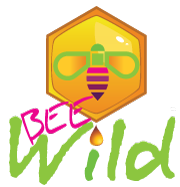WHAT’S BEE WILD REALLY ABOUT?
Customers who are familiar with the usual honey websites expect the Bee Wild website to be about honey from front to back. We acknowledge that there is a huge amount to know about honey, bees, beekeeping, and various environmental issues that effect honey production. It is our pleasure to provide you with this information and help you enjoy the amazing world of raw honey via our website, our Facebook Fan Page, and our Twitter, Pinterest, and Instagram feeds. (URLs for these valuable resources can be found below, or you can use the social media buttons on our web pages.)
However, we strive to be “not just another honey company” that hard sells you into purchasing products. That is why we provide you with valuable information about the things you care about: health, nutrition, gourmet foods, amazing clean “foodie” restaurants, as well as anything that helps you “bee yourself.”
How do we know these topics are important to you? After our owner, John Wright, met our customers face to face over the last few years, we sat down and asked the question, “How can we help our customers be, do, and have more?” Answering that question was the catalyst for developing the Bee Wild website and the content we share on social networks.
So, please feel free to visit us daily, with your questions and comments. We enjoy getting to know you and look forward to connecting. We also have a monthly newsletter. If you subscribe to the newsletter by filling in your contact information on the subscription form that floats over our home page, we know you will enjoy the content! Finally, please feel free to share our website, newsletter, and social media sites with your friends and family. Our dream is to grow the Bee Wild family and network the valuable information we share all over the world!
CAN YOU TELL ME SOMETHING ABOUT HONEY FLAVORS?
Our gourmet honeys have several flavor profiles. For instance, Sourwood honey is radically different than Wildflower or Orange Blossom. Sourwood has a light, buttery maple flavor and is best on croissants or biscuits. Wildflower honey is more floral and great as a sweetener for tea. Orange Blossom has a unique citrus flavor that pairs well with White or Oolong tea, as well as having its own health benefits. Gallberry honey is aromatic and slightly astringent. Tupelo honey smells hoppy and has a strong floral taste. All of these kinds of honey are wild-crafted by the bees themselves, from the food sources available from our home farm in the North Georgia mountains to subsidiary farms in Georgia and Florida.
In order to accustom yourself to the various varietal flavors of honey, we suggest a honey tasting party for you, your family, and friends. Our QueenBee wrote a post about putting together a honey tasting.
ISN’T YOUR HONEY THE SAME AS IN THE GROCERY STORE?
Umm… let me think… NOOOOOO!!!! Bee Wild’s honey is to grocery store honey as Château Lafite-Rothschild is to Mad Dog 20/20. First of all, our products actually are honey! There has been a huge scandal about foreign manufacturers marketing corn syrup as honey. Secondly, our honey is raw. Leaving it raw preserves the health benefits of honey such as reducing seasonal conditions like allergies, plus many other benefits that we talk about in our blog “Buzz Words”. Last, but not least, the biggest difference is the flavor! The honey in the grocery store can be a mixture of several kinds of honey, mixed so that every bottle of honey tastes the same. Our honey is packaged as “varietal”… much like there are different types of wine, each with its own unique flavor profile.
HOW DO BEES MAKE HONEY?
Worker bees gather nectar from flowers, add enzymes and reduce the moisture, producing the sweet treat we call honey.
MY HONEY HAS BECOME SOLID (CRYSTALLIZED), IS IT STILL GOOD?
In a word.. yes! Crystallization happens when the glucose separates out of the liquid honey. It’s a natural process and is not a problem AND it’s reversible. Try pouring the honey into a glass jar and placing the jar in warm water – the crystals should dissolve. You may even place the honey in a microwave-safe container and pop it in the microwave for a very short time – I would suggest stirring it every 10 seconds and not letting the honey get hot because it would cook the honey (remember, one of the things that makes it healthy is that it’s raw!). Don’t ever heat the plastic bottle as it will melt (and for heaven’s sake, don’t put the metal lid from the glass jar in the microwave. One last thought – you don’t have to do any of these things – the honey is perfectly good in its crystallized form – just spoon out some and spread it on bread or drop it in tea – it’s great!
DOES HONEY GO BAD OR HAVE AN EXPIRATION DATE?
Because bacteria can’t survive in honey, it doesn’t “go bad”. When honey is placed in a sealed container, it can last for decades, even centuries. Honey, however, may change chemically over time depending on temperature, etc…. It may crystallize (as previously stated), darken, or lose its aroma, though if properly packed, processed, and stored, it should last for a long time. Be your own judge – I tend to consider its shelf life 2-3 years, though why someone would take that long to eat something so tasty is beyond me. If it doesn’t look or smell right – you’re welcome to discard what’s left in the bottle and buy another bottle – just don’t wait so long to enjoy it.
HOW DO I SUBSTITUTE HONEY FOR SUGAR?
Honey has a higher sweetening power than sugar because of its high fructose content so you can use less honey than sugar to achieve the same result. If you’re following a recipe, start with half the amount of honey – if it calls for a cup of sugar, try half a cup of honey. If baking, reduce the heat by 25 degrees F to prevent over-browning and remember honey has a water content so reduce other liquids by 1/4 cup and add 1/2 teaspoon of baking soda for each cup of honey used. It may take a little trial and error, but you just might end up with a prize-winning recipe on your hands.
WILL EATING LOCAL HONEY HELP WITH MY ALLERGIES?
We make no health claims about our honey, though there are many anecdotal stories of people claiming eating a spoonful of honey a day starting a couple of months before allergy season can help stave off seasonal “conditions”. On a personal level, my family swears by it and we’re almost never sick, though we’re not aware of scientific evidence to support these claims. Some experts claim that the pollen grains that are in honey are much larger (and sometimes of a different kind) than the pollen that cause allergies. In the end, as with anything, decide for yourself. Honey helping with allergies may be an “old wives tale, but it definitely is a superfood (Anti-microbial qualities allows honey to be used in hospitals for wound healing, for example), and we would think it could only help.
WHY CAN’T I FEED HONEY TO MY BABY LESS THAN 1 YEAR OF AGE?
Honey is not recommended for babies because of a possible link to infant botulism, a rare, but serious disease caused by spores of C botulinum that may be found in honey. C botulinum spores are commonly found throughout the environment in dust, soil, and improperly canned food (ever seen a bloated can of mushrooms?). Realize our honey is raw; most foods are heated to high temperatures which deactivates these spore (and much of the nutrition within). Adults and children over one year of age are routinely exposed to C. botulinum but are normally not affected. Babies, on the other hand, haven’t yet developed their immune systems and gastrointestinal tract to fight off these common environmental toxins. Honey is safe to consume during pregnancy and lactation as the unborn baby is protected by the mother’s immune system.

